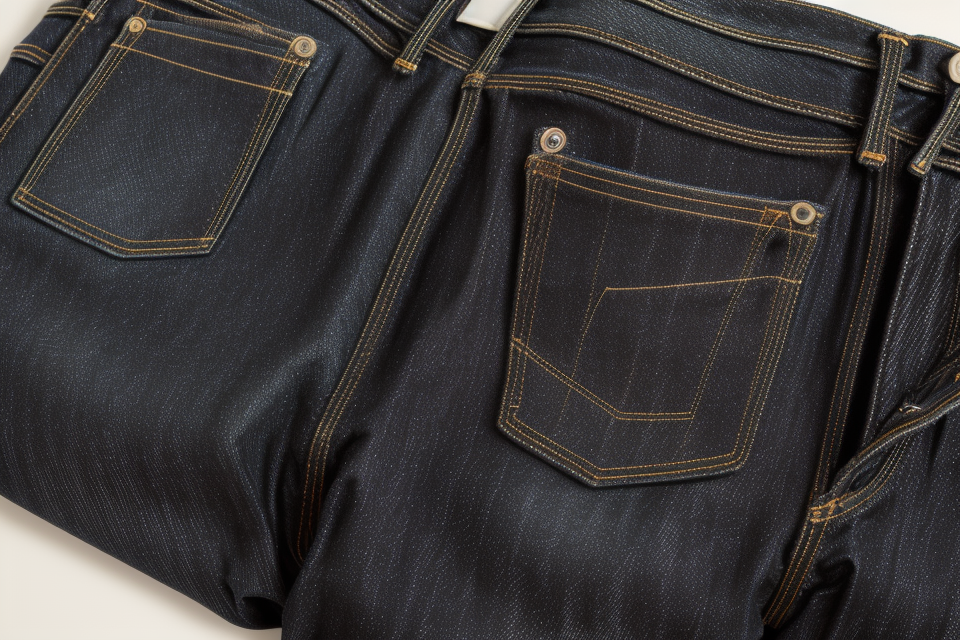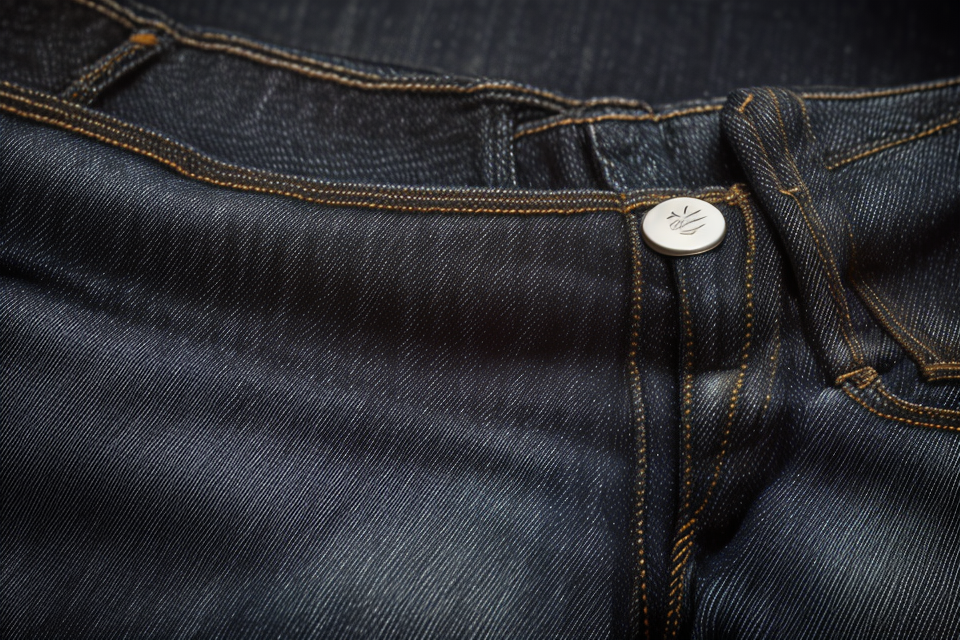Jeans are a wardrobe staple for many of us, but have you ever stopped to consider how washing them affects their fit, durability, and appearance? From fading and shrinking to losing their shape, the effects of washing jeans can be significant. In this article, we’ll explore the ways in which washing jeans can impact their overall quality and style, and provide tips on how to keep your jeans looking and feeling their best. So whether you’re a die-hard denim enthusiast or simply looking to keep your jeans in top condition, read on to discover the effects of washing jeans and how to care for them properly.
Washing jeans can have a significant impact on their fit, durability, and appearance. When jeans are washed, the fabric fibers can stretch and lose their shape, causing them to become looser and potentially leading to sagging or loss of fit over time. The frequency and method of washing can also affect the durability of the jeans, with hot water and harsh detergents potentially damaging the fabric and causing wear and tear. In terms of appearance, washing can remove dirt and stains, but it can also cause color fading or distortion, particularly in dark-colored jeans. To maintain the fit, durability, and appearance of jeans, it is recommended to wash them less frequently, use cold water and a gentle detergent, and avoid using bleach or fabric softener.
The importance of washing jeans
Why jeans need to be washed
Jeans are a versatile and practical garment that can be worn in a variety of settings. However, to maintain their fit, durability, and appearance, they require regular washing. Here are some reasons why jeans need to be washed:
- Eliminating odor and bacteria: Jeans are made of natural fibers, which can absorb sweat and other body odors. Over time, these odors can become stronger and more noticeable. Washing jeans removes the odor-causing bacteria, leaving them fresh and clean.
- Removing sweat and dirt: Jeans are often worn for outdoor activities, such as hiking or biking, which can result in sweat and dirt stains. These stains can damage the fabric and affect the appearance of the jeans. Washing jeans removes sweat and dirt, preventing stains from setting in and maintaining the jeans’ original color.
- Maintaining a fresh appearance: Jeans are a wardrobe staple that can be worn for many occasions. However, even with proper care, jeans can start to look worn and faded over time. Washing jeans regularly helps to maintain their fresh appearance, keeping them looking new and vibrant.
In summary, washing jeans is essential to maintain their fit, durability, and appearance. It removes odor-causing bacteria, removes sweat and dirt stains, and helps to maintain a fresh appearance. By following proper washing and care instructions, jeans can last longer and continue to look their best.
How often should jeans be washed?
Washing jeans is an essential part of maintaining their fit, durability, and appearance. However, the frequency of washing depends on several factors, including the type of jeans, the material they are made of, and how often they are worn.
- Factors affecting the frequency of washing:
- The material: Jeans made of cotton are generally easier to wash than those made of denim or other materials.
- The construction: Jeans with reinforced seams or stitching may require more frequent washing.
- The color: Light-colored jeans may require more frequent washing to prevent fading.
- The wearer’s lifestyle: Jeans that are worn daily or exposed to harsh environments may require more frequent washing.
- A general guideline for washing jeans:
- Dark-wash jeans: Can be washed every 2-3 weeks.
- Light-wash jeans: Can be washed every 1-2 weeks.
- Raw or unwashed jeans: Can be washed every 1-2 months.
- Jeans with special finishes: May require more frequent washing or professional cleaning.
It is important to note that over-washing jeans can cause them to lose their shape, fade, and become damaged. Therefore, it is recommended to follow the guidelines above and wash jeans based on their specific needs.
The effects of washing on jeans
Impact on fit
Washing jeans can have a significant impact on their fit, resulting in changes that may affect their overall appearance and feel. Two key factors that can be affected by washing are shrinkage and stretching.
Shrinkage and its consequences
Shrinkage is a common occurrence when washing jeans, especially if they are made of cotton. This occurs because cotton fibers absorb water and then contract when they dry, leading to a reduction in size. The amount of shrinkage can vary depending on the type of cotton used, the dye used to color the jeans, and the washing method used. Shrinkage can be significant, particularly in areas such as the waistband and the hems, which can result in a loose fit.
Stretching and its effects on fit
On the other hand, washing can also cause jeans to stretch, particularly if they are made of denim. This can occur due to the mechanical action of the washing machine or due to the use of hot water, which can cause the fibers to relax and expand. Stretching can lead to a looser fit, particularly in areas such as the thighs and seat, which can make the jeans feel more comfortable but also less defined.
In addition to these changes, washing can also affect the overall appearance of the jeans. Fading, for example, can occur if the jeans are washed frequently or if they are exposed to sunlight while drying. This can create a worn or vintage look, but it can also detract from the original design of the jeans.
Overall, the impact of washing on the fit, durability, and appearance of jeans can be significant. By understanding these effects, you can make informed decisions about how to care for your jeans and ensure that they continue to look and feel their best.
Impact on durability
When it comes to the durability of jeans, there are several factors that come into play. These include the fabric, the construction, and the care and maintenance of the jeans. Washing jeans can have a significant impact on their durability, as it can affect the strength and resilience of the fabric.
- Factors that affect the longevity of jeans
- The fabric used to make the jeans can have a big impact on their durability. For example, denim made from 100% cotton is generally more durable than denim made from a blend of cotton and other materials.
- The construction of the jeans can also affect their longevity. Jeans with reinforced seams or double stitching are generally more durable than those with standard construction.
- The care and maintenance of the jeans can also play a role in their durability. Jeans that are washed and dried properly, without being damaged by heat or rough handling, will generally last longer than those that are not properly cared for.
- How washing affects the strength and resilience of jeans
- Washing jeans can have both positive and negative effects on their durability. On the one hand, washing can remove dirt and grime that can weaken the fabric over time. On the other hand, washing can also cause wear and tear on the jeans, particularly if they are washed too frequently or with harsh detergents.
- The method of washing can also affect the durability of jeans. For example, washing jeans by hand in cold water and mild soap is generally less damaging than washing them in a machine with hot water and harsh detergents.
- Finally, the way in which jeans are dried can also impact their durability. Air-drying is generally the best option, as it can help prevent shrinkage and damage from heat.
Impact on appearance
Washing jeans can have a significant impact on their appearance. Over time, the fabric may fade, change color, develop holes and tears, and acquire wrinkles and creases.
Fading and color changes
Repeated washing can cause denim to fade, lose its original color, and develop a worn-out look. This is because the dye used in denim is not colorfast, meaning it can run or bleed when exposed to water, soap, and rubbing. The degree of fading depends on several factors, including the type of denim, the color of the jeans, the washing method, and the detergent used.
Jeans made from darker shades of denim, such as black or navy, tend to fade more quickly than lighter shades like light blue or white. This is because darker colors have more dye, which is more likely to run during washing. Also, jeans with a higher concentration of indigo, such as raw denim, are more resistant to fading than those with a lower concentration.
To minimize fading, it’s essential to wash jeans less frequently and follow specific washing techniques. Washing jeans in cold water and using a garment bag or washing net can help prevent dye from bleeding. Avoiding the use of chlorine bleach on protein-based fibers like silk and cashmere can also help prevent fading.
Holes and tears
Repeated washing can cause holes and tears in jeans, especially around the pocket area, knees, and crotch. This is because the agitation and abrasion caused by the washing machine’s spin cycle can weaken the denim fibers, leading to small tears that eventually become larger holes.
To prevent holes and tears, it’s important to wash jeans inside out and turn them right side out only after the wash cycle is complete. Avoiding the use of fabric softener can also help, as it can weaken the fibers and make them more susceptible to damage.
Wrinkles and creases
Washing jeans can cause wrinkles and creases, which can make them look older and less appealing. This is because the denim fibers can shrink, distort, and lose their original shape during the washing process.
To minimize wrinkles and creases, it’s important to wash jeans inside out and avoid using fabric softener. Hanging jeans up to dry instead of using the dryer can also help prevent wrinkles from forming. Ironing jeans can help remove wrinkles, but it’s important to use a low heat setting and avoid ironing over any decorative stitching or embellishments.
Proper washing techniques for jeans
Pre-wash preparation
Before washing your jeans, it’s important to properly prepare them to ensure they come out looking their best. Here are some steps you can take to prepare your jeans for washing:
- Remove pockets and zippers: Jeans typically have a lot of small details, such as pockets and zippers, that can get caught on other clothes during washing. To prevent damage to your jeans, it’s best to remove these details before washing. This can be done by unfastening any buttons or zippers and carefully cutting out the pockets.
- Turn jeans inside out: Jeans are typically made with a combination of cotton and denim fibers, which can make them prone to fading and discoloration. To help prevent these issues, it’s best to turn your jeans inside out before washing. This will help protect the fabric from wear and tear, and will also help to keep the color of your jeans looking more vibrant.
- Check for any loose or broken threads: Before washing your jeans, it’s a good idea to check for any loose or broken threads. These can often be found around the hem or in the seams of your jeans. If you find any loose or broken threads, it’s best to remove them before washing to prevent them from becoming even more frayed during the washing process.
By following these simple steps, you can help ensure that your jeans look their best and last longer over time.
Washing machine settings
Washing machine settings play a crucial role in determining how your jeans will turn out after washing. Here are some essential factors to consider:
- Water temperature: The temperature of the water you use to wash your jeans can affect their color, texture, and shape. Cold water is usually recommended for dark-colored jeans, as hot water can cause them to fade or shrink. However, if you have light-colored jeans, hot water can help remove tough stains and dirt. It’s generally advised to use cold water for denim jeans to preserve their shape and color.
- Washing powder or liquid: The type of detergent you use can also impact the appearance and durability of your jeans. It’s best to use a mild, gentle detergent that is free from harsh chemicals and fragrances. These can damage the fabric and cause it to lose its shape and color over time. Additionally, using a detergent that is specifically designed for denim can help to maintain the texture and integrity of the fabric.
- Spin cycle: The spin cycle is responsible for removing excess water from your jeans after washing. If the spin cycle is too strong, it can cause your jeans to lose their shape and become misshapen. To avoid this, it’s recommended to use a lower spin speed or to hang your jeans up to dry instead of putting them in the dryer. Additionally, if you have pockets with buttons or other small objects, it’s best to turn them inside out before washing to prevent damage to the buttons or the pockets themselves.
Drying and folding
Drying and folding are crucial steps in the laundering process for jeans. Improper techniques can lead to shrinkage, loss of shape, and even damage to the fabric.
Tumble drying vs. air drying
Tumble drying jeans is not recommended, as it can cause shrinkage and loss of shape. If you must tumble dry your jeans, it’s best to use a low heat setting and remove them from the dryer as soon as they’re dry.
Air drying is the preferred method for washing jeans. It’s gentler on the fabric and helps to prevent shrinkage and loss of shape. Hang your jeans up to dry in a well-ventilated area, away from direct sunlight.
Proper folding techniques
Improper folding can cause wrinkles and creases in the fabric, which can lead to an uneven fit and a worn appearance. To properly fold your jeans, start by laying them flat and straightening them out. Fold them in half once, then fold them in half again, so that they are now quartered. Finally, fold each quarter in half once more, creating a neat, compact package.
Tips for extending the life of jeans
Proper storage
Proper storage of jeans is essential to maintain their fit, durability, and appearance. Here are some tips for storing jeans:
- Hanging or folding: Jeans can be stored by hanging them on a hook or folding them and placing them in a storage box or drawer. Hanging jeans is recommended as it helps maintain their shape and prevents wrinkles. Folding jeans can cause creases, but it is a good option if you don’t have enough space to hang them.
- Keeping jeans away from heat sources: Heat can cause damage to jeans, so it’s important to keep them away from direct sunlight, radiators, and other heat sources. This can help prevent shrinking, fading, and other damage to the fabric.
It’s also a good idea to rotate your jeans to ensure even wear and tear. Wearing the same pair of jeans every day can cause uneven fading and wear and tear on the areas where they rub against your body. By rotating your jeans, you can distribute the wear and tear evenly and prolong their lifespan.
Spot cleaning
Cleaning small stains and dirt spots
When it comes to jeans, spills and stains are inevitable. However, instead of washing the entire pair of jeans every time a small stain appears, it’s better to spot clean them. Spot cleaning is a method of cleaning only the affected area of the jeans, rather than washing the entire pair. This method can help prevent damage to the fabric and maintain the overall integrity of the jeans.
Using spot cleaning solutions or detergents
There are several spot cleaning solutions and detergents available in the market that can be used for cleaning small stains on jeans. These solutions are designed to be gentle on denim fabric and can help remove stains without causing any damage. When using a spot cleaning solution or detergent, it’s important to follow the instructions carefully and test the solution on a small, inconspicuous area of the jeans before applying it to the stain. This can help prevent any unwanted damage to the fabric.
It’s also important to note that not all stains can be removed using spot cleaning methods. If the stain is particularly stubborn or has set in, it may be necessary to wash the entire pair of jeans. However, spot cleaning is a great option for removing small stains and dirt spots, and can help extend the life of your jeans.
Professional cleaning
Professional cleaning is an excellent way to maintain the fit, durability, and appearance of your jeans. However, it is essential to know when to consider this option and how to choose a reputable cleaner.
When to consider professional cleaning
Professional cleaning is recommended when your jeans show visible signs of wear and tear, such as fading, discoloration, or worn-out patches. This service is particularly beneficial for premium denim that requires special care to maintain its quality. Additionally, if you notice any stains or damage that you cannot remove on your own, it’s best to seek professional help.
Tips for choosing a reputable cleaner
- Research: Look for recommendations from friends, family, or online reviews. This research will help you identify reliable cleaners in your area.
- Experience: Choose a cleaner with experience in denim garments, preferably one that specializes in jeans. Their expertise will ensure your jeans receive the appropriate care and attention they need.
- Services offered: Check if the cleaner offers a range of services, such as spot cleaning, repairing, and restoration. This variety of services will ensure your jeans receive the necessary care and attention to maintain their quality.
- Pricing: Compare prices among different cleaners to ensure you’re getting a fair deal. However, remember that cheap prices may indicate poor quality or insufficient experience, so it’s essential to strike a balance between cost and quality.
- Quality assurance: Verify if the cleaner uses eco-friendly and safe cleaning methods, such as ozone washing or laser repair. These methods are more gentle on your jeans and will help maintain their longevity.
By following these tips, you can ensure that your jeans receive the professional care they need to maintain their fit, durability, and appearance.
FAQs
1. What are the effects of washing jeans on their fit?
Washing jeans can have both positive and negative effects on their fit. On the one hand, washing can help to remove any excess fabric or lint that may be bunched up in the seams, resulting in a more comfortable and tailored fit. However, over time and with repeated washing, jeans may shrink or stretch out of shape, leading to a looser or tighter fit. This can depend on the type of denim and the care instructions provided by the manufacturer.
2. How does washing affect the durability of jeans?
Washing jeans can have an impact on their durability, depending on the method used. Using a gentle cycle and cold water can help to reduce wear and tear on the fabric, while using harsh detergents or excessive heat can weaken the fibers and cause damage. Additionally, over-washing or washing jeans too frequently can lead to breakdown of the fabric and loss of shape. To maintain the durability of jeans, it’s recommended to follow the care instructions provided by the manufacturer and wash them less frequently.
3. Can washing jeans affect their appearance?
Yes, washing jeans can have an effect on their appearance. Over time, washing can cause colors to fade, buttons to lose their shine, and the overall texture of the fabric to change. Additionally, using harsh detergents or excessive heat can cause damage to the fabric and lead to a worn or faded appearance. To maintain the appearance of jeans, it’s recommended to use a gentle detergent and cold water, and to avoid washing them too frequently. Additionally, it’s important to follow the care instructions provided by the manufacturer to ensure the best possible results.



